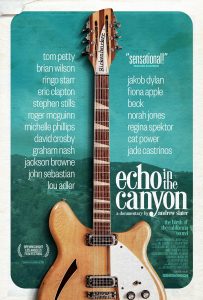
From 1965 to 1967, an extraordinary collection of musicians and songwriters lived near each other in Laurel Canyon in Los Angeles: Brian Wilson, Joni Mitchell, Graham Nash, Stephen Stills, David Crosby, and more. They spent a lot of time visiting and hanging out in each others’ houses, sharing new musical ideas as well as beds and drugs. It was the era of folk music going electric and the birth of the California sound.
”Echo In The Canyon” is a documentary by Andrew Slater about those people and those years, containing interviews with many of those who lived there, as well as others who were influenced by them. Tom Petty (in his last filmed interview) talks about how Byrds founder Roger McGuinn essentially created folk-rock when he moved out from New York with his trademark 12-string Rickenbacker sound, while McGuinn, in another clip, says all he did was add a Beatles beat to the folk music he’d grown up with.
In contemporary footage, Michelle Phillips remembers her days with Mama Cass, Denny Doherty, and John Phillips in The Mamas And Papas, while archival footage reveals how, in the mid-sixties, she was the epitome of the natural Californian look (I can easily argue that she was the most beautiful rock star I’ve ever seen). Meanwhile, David Crosby reveals the real reason he left the Byrds (spoiler alert: they kicked him out because he was acting like an asshole) and Stephen Stills tattles on himself, telling the story of the night he jumped out the back window to avoid being arrested when the cops showed up to a party where everyone was using drugs.
The interviews were conducted by Jakob Dylan, and are framed by scenes of him putting on an Echo In The Canyon concert in which he performed songs by those classic rock artists, aided by Fiona Apple, Beck, Norah Jones, and Regina Spektor. Slater does a good job editing different clips of the songs into a linear form, with the originals spliced right up against the remakes. The problem is that Dylan and his colleagues merely reproduced the songs without a new take on any of them, so why do we need to hear them when we have audio and video recordings of those classics?
There are also a few scenes where Dylan and friends sit in a living room sifting through a tabletop covered with those old albums, but they didn’t know the history behind what they were looking at and thus didn’t have much to say about them. What a waste.
Better are the conversations with Ringo Starr and Eric Clapton, who remember the influence they got in return from the creative forces in Laurel Canyon. They both mention how they had started out copying American rock pioneers like Chuck Berry, then took that to their own new level, only to have it reimagined by the Californians, and then turned into something even more advanced in England (e.g. “Sgt. Pepper’s”). It’s a nice acknowledgement of how the inspirers became the inspired and then vice-versa. If only the documentary had more insight like that instead of the tribute-band-like concert footage of Dylan and his personal passion project.
Still, “Echo In The Canyon” does serve as a kind of history lesson for viewers who love the music of that era but don’t know the backstory of the generation of musicians who left an indelibly positive mark on the narrative of rock and roll. Thus, I’m giving it a 6.5 out of 10.
The movie opens in select theaters tomorrow (including The Tivoli in St. Louis).
